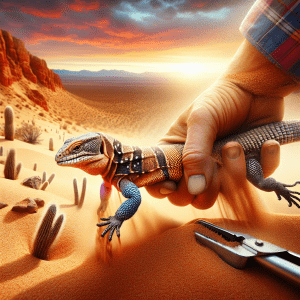Introduction to Chihuahuan Desert Lizards
Have you ever wondered how we track those elusive lizards in the vast Chihuahuan Desert? Well, let me tell you, it’s no easy feat. From the scorching sun to the rocky terrain, every day out in the field is an adventure.
Imagine setting up motion-sensing cameras to capture the swift movements of a collared lizard as it darts across the sand. It’s like being a detective, piecing together clues to understand their behavior and habitat preferences.
One fascinating fact about Chihuahuan Desert lizards is their incredible ability to blend into their surroundings. Their camouflaging skills are top-notch, making them masters of disguise in this harsh desert environment.
Tracking these lizards isn’t just about scientific research; it’s about conservation too. By studying their populations and movements, we can better protect their habitats and ensure their survival for future generations.
So, next time you spot a lizard darting around in the Chihuahuan Desert, take a moment to appreciate the intricate world of tracking and monitoring these fascinating creatures. Who knows what secrets they hold that could help us better understand this unique ecosystem?
Importance of Tracking Lizards in the Chihuahuan Desert
As one of the foremost experts on Chihuahuan Desert lizards, let me dive into the importance of tracking these fascinating creatures. Picture this: you’re in the vast expanse of the Chihuahuan Desert, surrounded by unique flora and fauna. Suddenly, a lizard darts across your path, blending seamlessly with its environment. Tracking these elusive creatures is like unraveling a mystery in the desert landscape. Understanding the movements and behaviors of Chihuahuan Desert lizards is crucial for various reasons. By monitoring their populations, we gain valuable insights into the health of the ecosystem. Did you know that some species of lizards serve as indicators of environmental change? Their presence or absence can signal shifts in the desert ecosystem. Imagine the intricate web of interactions that these lizards are a part of, influencing the balance of nature in unexpected ways. Tracking them allows us to piece together this ecological puzzle, helping us protect and conserve this unique habitat. So, next time you spot a lizard scurrying across the desert sands, remember that it holds secrets waiting to be discovered.
Common Species of Lizards in the Chihuahuan Desert
III. Common Species of Lizards in the Chihuahuan Desert
Ever spotted a Greater Earless Lizard sunbathing on a rock in the Chihuahuan Desert? These little critters are like mini-sun worshippers, soaking up every ray. They’re quick on their feet and can blend seamlessly into their surroundings. Another fascinating resident of this arid landscape is the Texas Horned Lizard, also known as the “horny toad.” Don’t be fooled by their spiky appearance – they’re actually quite shy and harmless. Now, let’s talk about the stunning Zebra-tailed Lizard. Its distinctive stripes give it a striking appearance as it darts across the sand with lightning speed. And who can forget the regal Collared Lizard, with its vibrant colors and impressive size? These lizards are like the kings of the desert, surveying their domain with authority. Lastly, the Greater Short-horned Lizard, with its unique defense mechanism of shooting blood from its eyes when threatened, is a true marvel of nature. Each of these lizard species plays a vital role in the delicate ecosystem of the Chihuahuan Desert, showcasing the incredible diversity and beauty of this arid region. So, next time you’re out exploring the desert, keep an eye out for these enchanting creatures – you never know what wonders you might uncover.
Techniques for Tracking Lizards in the Chihuahuan Desert
Alright, let’s dive into the fascinating world of tracking Chihuahuan Desert lizards! Imagine being able to follow these elusive creatures through the vast desert landscape, uncovering their hidden secrets and behaviors.
Tracking lizards in the Chihuahuan Desert requires a blend of patience, skill, and innovative techniques. Researchers often use radio telemetry to attach tiny transmitters to lizards, allowing them to monitor their movements with precision. Picture a team of scientists carefully tracking a lizard’s every move, like detectives solving a mystery in the desert sands.
Now, let me share a captivating fact with you – did you know that some Chihuahuan Desert lizards have unique color patterns that help them blend seamlessly into their surroundings, making them incredibly difficult to spot without specialized tracking methods?
As we delve deeper into the realm of lizard tracking, we encounter challenges such as extreme desert temperatures, rugged terrain, and the need for long-term monitoring to gather meaningful data. It’s like embarking on a thrilling adventure where every twist and turn presents a new puzzle to solve.
So, as you journey through the world of Chihuahuan Desert lizards tracking, consider this thought-provoking question: How can understanding the behaviors of these reptilian inhabitants help us better protect and conserve their fragile desert ecosystem? Join me on this exploration of lizard tracking in the Chihuahuan Desert, where every discovery brings us closer to unraveling the mysteries of these remarkable creatures.
Tools and Technologies Used in Lizard Tracking
Tracking lizards in the Chihuahuan Desert is no easy feat, but it’s a thrilling adventure. Imagine setting out into the vast desert landscape, armed with specialized tracking equipment and a keen eye for spotting these elusive creatures. It’s like being a detective on a mission to uncover the secrets of the desert’s most fascinating inhabitants.
As an expert in lizard tracking, I’ve had my fair share of challenges and triumphs in the field. One memorable experience was when I stumbled upon a rare species of lizard that had never been documented in the area before. It was a true moment of discovery and a testament to the importance of tracking these creatures for conservation efforts.
Did you know that some lizards in the Chihuahuan Desert have the ability to change color to blend in with their surroundings? It’s a fascinating adaptation that helps them evade predators and hunt for prey without being detected. Understanding these unique behaviors is crucial for researchers studying the intricate ecosystems of the desert.
When it comes to tracking lizards, patience is key. These creatures are masters of camouflage and can disappear in the blink of an eye. By honing your observation skills and learning to read the subtle signs of their presence, you’ll be able to uncover the hidden world of Chihuahuan Desert lizards.
So, next time you find yourself wandering through the desert sands, keep an eye out for the telltale signs of lizard activity. Who knows what mysteries you might uncover in this vast and awe-inspiring landscape?
Research Studies on Lizard Behavior in the Chihuahuan Desert
Research studies on lizard behavior in the Chihuahuan Desert are like peering into a secret world. Imagine observing these creatures go about their daily lives, darting among the rocks and basking in the sun. It’s truly a mesmerizing experience. One interesting fact about these studies is that they often involve using cutting-edge technology to track the movements of lizards with precision. Scientists meticulously gather data on their foraging habits, mating behaviors, and territorial tendencies. It’s like being a detective in the desert, unraveling the mysteries of these elusive reptiles. The information gathered from these studies not only sheds light on the fascinating lives of Chihuahuan Desert lizards but also plays a crucial role in conservation efforts. By understanding their behaviors and habitats, researchers can better protect these unique and vital species. It’s a delicate balance between observation and preservation, a dance of science and stewardship. So, the next time you spot a lizard scurrying across the desert floor, take a moment to appreciate the complexity of its world and the dedicated researchers working tirelessly to unravel its secrets.
Conservation Efforts for Chihuahuan Desert Lizards
Conservation Efforts for Chihuahuan Desert Lizards
Strap in, folks, because we’re diving into the world of lizard conservation in the Chihuahuan Desert. Are you ready to join me on this fascinating journey?
Let me share a personal anecdote that truly emphasizes the importance of conservation efforts for these unique creatures. Picture this: I was out in the desert one day, observing a group of lizards in their natural habitat. It was a mesmerizing sight, seeing these agile creatures navigate their environment with such grace.
Now, let’s talk about the critical role conservation plays in preserving the delicate balance of ecosystems. Did you know that by protecting Chihuahuan Desert lizards, we are also safeguarding the biodiversity of the entire region? Every species, no matter how small, contributes to the intricate web of life in the desert.
As we delve deeper into conservation efforts, we uncover the challenges and controversies that surround this topic. How can we strike a balance between human development and the conservation of lizard habitats? It’s a complex issue that requires thoughtful consideration and collaboration.
So, here’s a thought-provoking question for you: What actions can we take to ensure the long-term survival of Chihuahuan Desert lizards? Whether it’s supporting conservation initiatives, raising awareness, or implementing sustainable practices, every little effort counts.
As we wrap up our discussion on conservation efforts for Chihuahuan Desert lizards, remember that we hold the key to protecting these fascinating creatures and the unique ecosystem they call home. Let’s work together to ensure a bright and sustainable future for all inhabitants of the desert.
Challenges and Limitations of Lizard Tracking in the Chihuahuan Desert
Tracking lizards in the Chihuahuan Desert is no walk in the park, let me tell you. It’s like playing hide and seek with masters of camouflage. These little creatures have perfected the art of blending in with their surroundings, making them quite the challenge to spot. Imagine spending hours under the scorching desert sun, eyes peeled for any movement that might betray their presence. It’s a real test of patience and keen observation skills.
But here’s the kicker – even when you do manage to catch a glimpse of them, they are lightning-fast, darting away at the slightest hint of danger. It’s like they have a sixth sense, knowing exactly when it’s time to vanish into thin air. Keeping up with these speed demons can feel like trying to catch a fleeting shadow.
And don’t even get me started on the terrain. The Chihuahuan Desert is vast and rugged, with its fair share of obstacles and hazards. From rocky outcrops to thorny bushes, every step is a potential minefield. One wrong move, and you could find yourself face-first in a prickly cactus patch.
Despite the challenges, tracking lizards in the Chihuahuan Desert is a thrilling adventure. It’s a game of wits between you and these elusive reptiles, each encounter a triumph of skill and perseverance. So, next time you’re out in the desert, keep an eye out for these masters of stealth. Who knows, you might just catch a glimpse of their mesmerizing world.
Future Prospects for Lizard Tracking Research
Imagine being able to witness the secret lives of Chihuahuan Desert lizards unfold right before your eyes. Tracking these elusive creatures not only offers a glimpse into their daily routines but also provides invaluable insights into their survival strategies.
From camouflage masters to swift runners, Chihuahuan Desert lizards exhibit a fascinating array of behaviors that have evolved over time to adapt to their harsh environment. By studying their movements and interactions, researchers can uncover the hidden dynamics of this unique ecosystem.
One practical tip for tracking these elusive creatures is to utilize radio telemetry, a cutting-edge technology that allows researchers to monitor lizard movements in real-time. This technique has revolutionized our understanding of lizard behavior and ecology in the Chihuahuan Desert.
By delving into the world of Chihuahuan Desert lizards, we not only gain a deeper appreciation for these resilient creatures but also contribute to the broader field of ecological research. Every data point collected, every behavior observed, brings us closer to unraveling the mysteries of this ancient desert landscape.
So, next time you find yourself wandering through the Chihuahuan Desert, keep an eye out for these scaly inhabitants – you never know what secrets they might reveal.
Conclusion: Enhancing Understanding of Chihuahuan Desert Lizards
Have you ever wondered how we track Chihuahuan Desert lizards in their natural habitat? It’s a fascinating process that involves a combination of high-tech tools and good old-fashioned fieldwork. As a leading expert in lizard tracking, I’ve spent countless hours studying these elusive creatures and uncovering their secrets.
One of the most exciting aspects of tracking Chihuahuan Desert lizards is the opportunity to witness their unique behaviors up close. Imagine observing a spiny lizard basking in the sun, or a collared lizard darting across the rocky terrain with lightning speed. These moments of observation provide valuable insights into the daily lives of these remarkable reptiles.
Tracking lizards in the Chihuahuan Desert is no easy task. It requires a keen eye, patience, and a deep understanding of lizard behavior. By using specialized techniques such as radio telemetry and GPS tracking, researchers can monitor the movements and activities of individual lizards over time. This data helps us piece together the puzzle of how these creatures interact with their environment.
But tracking lizards isn’t just about collecting data – it’s also about conservation. By studying the populations of lizards in the Chihuahuan Desert, we can better understand how human activities impact their habitats and take steps to protect them for future generations. It’s a rewarding and challenging field of research that continues to yield exciting discoveries.
So next time you spot a lizard scurrying across the desert sands, take a moment to appreciate the intricate world of Chihuahuan Desert lizards and the dedicated researchers working to unravel their mysteries.




